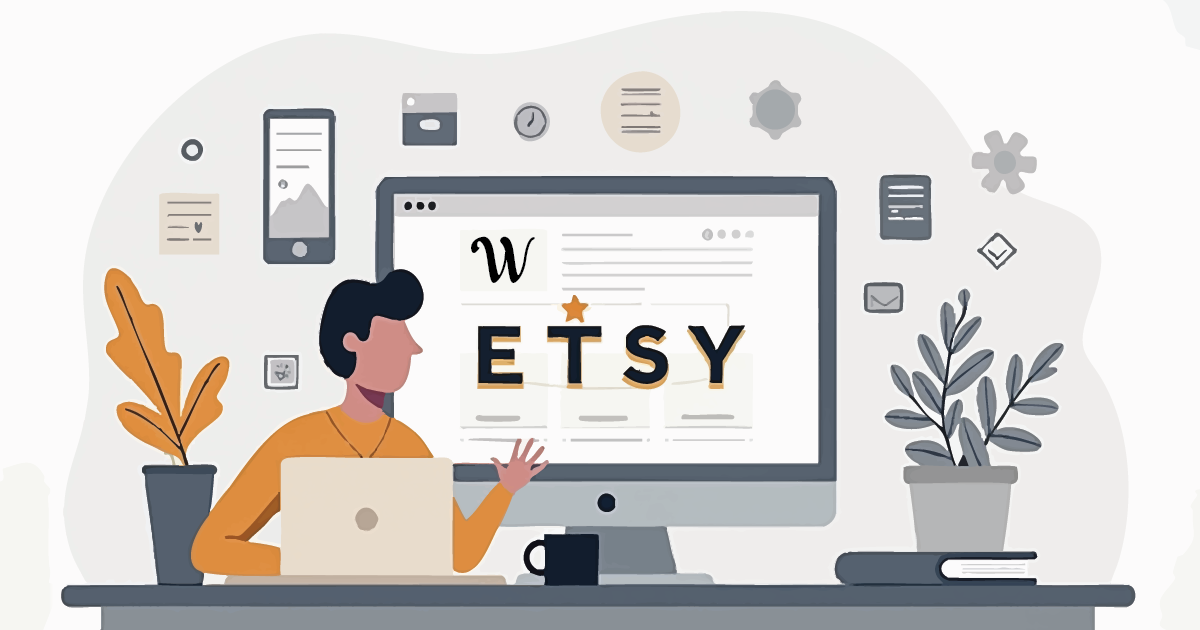The Quick Bridge I Use to List Faster
What “mirroring” really means (manage expectations)
When you mirror an Etsy listing into WooCommerce, you’re aiming to carry over: title, description, images, price, variations, SKU, and inventory. Connectors like CedCommerce’s Etsy Integration and LitCommerce can import existing Etsy listings and sync stock/orders either direction, depending on setup.
Two useful notes up front:
• Etsy limits listings to at most two variation attributes (e.g., Size + Color). If your WooCommerce product uses three or more options, you’ll need to simplify for Etsy.
• Etsy requires a shipping profile on every listing; if you ever push products from WooCommerce to Etsy, make sure profiles are in place. Digital listings also need the is_digital flag (on Etsy) and an uploaded file.
Option A — One-off manual copy (5–10 minutes)
Best when you just need to add one Etsy item to WooCommerce quickly.
- In WordPress, go to Products → Add New and paste your Etsy Title and Description.
- Upload the same images from your local files (download them from Etsy first if needed).
- Set Regular price (and Sale price if used on Etsy).
- SKU: copy the Etsy SKU (or make one now). SKUs are your friend if you later enable sync.
- Attributes & Variations: recreate Etsy variations. Remember Etsy’s two-variation limit if you plan to sync both ways.
- Publish. You’ve mirrored the product in Woo.
When to choose this: You don’t need bulk actions, and inventory can be managed per-site for now.
Option B — Connector app (bulk import + ongoing sync)
Best when you want to import many Etsy listings into WooCommerce and keep stock/orders aligned.
Connector choices I’ve used or vetted
- Etsy Integration for WooCommerce (CedCommerce on Woo Marketplace). Imports Etsy listings, syncs inventory, and can manage Etsy orders inside Woo. Good fit if you want a Woo-native workflow.
- LitCommerce (multichannel tool). Connects WooCommerce ↔ Etsy (and other channels), supports bulk listing, real-time inventory sync, and centralized order handling. Nice UI, free trial.
Typical setup flow (both tools are similar)
- Install & connect. Activate the plugin/app, then authenticate your Etsy shop and Woo store.
- Import Etsy listings. Pull selected (or all) Etsy products into WooCommerce as products (drafts or published). Map categories/attributes while importing.
- Set sync rules. Choose the “source of truth” (Woo or Etsy) for price, title, and inventory. Turn on order sync if you want Etsy orders to appear in Woo.
- Test with 1–2 SKUs. Verify variations, images, tax, and shipping before bulk-running.
When to choose this: You care about speed, accuracy, and future updates without double-editing.
Option C — CSV import (spreadsheet comfort zone)
WooCommerce includes a Product CSV Importer/Exporter (Products → All Products → Import/Export). It’s great for bulk edits and initial population. The catch: Etsy doesn’t offer a clean, official “export listings CSV” for everything you need; you’ll usually rely on a connector or a third-party export to build a Woo-friendly CSV. If you do go CSV, use Woo’s importer to map columns to product fields and variations.
When to choose this: You prefer spreadsheets and don’t need continuous sync.
Gotchas (and quick fixes)
- Two-variation ceiling on Etsy. If your Woo product has Size + Color + Material, collapse Material into the description or options notes for your Etsy mirror.
- Variation images. Etsy’s API ties variation images to specific properties; mismatches can throw errors. If a connector fails to map color → image, set them directly in Etsy, then re-sync.
- SKUs & stock. Pick a consistent SKU scheme and stick with it. Sync tools depend on SKUs for reliable inventory updates.
- Shipping & digital files (Etsy). Make sure your Etsy shipping profiles are created and assigned; digital items must be flagged and have a file uploaded on Etsy’s side.
- Connector expectations. Features vary by tool (import, auto-sync, order routing, etc.). Skim the vendor docs/marketplace page before committing.
My 10-minute “bridge” checklist
- Decide path: Manual (one-off) vs Connector (many + sync).
- If connector: install, connect Etsy, import 1–2 listings, confirm variations/images → then bulk import.
- Lock SKU rules and sync directions (which side edits win).
- Spot-check a live product page in Woo (gallery, price, variations) and in Etsy (variation images, shipping profile).
- Flip on order sync (optional), fulfill a test order, confirm stock decrements in both.
FAQ (quick hits)
Can I just copy/paste and be done?
Yes—for a single listing, manual is fine. When your catalog grows, use a connector to save time and avoid stock mismatches.
Will CSV give me everything from Etsy?
Woo’s importer is excellent—but Etsy doesn’t hand you a perfect, official listings CSV. Most shops end up using a connector or third-party exporter to build a usable file.
Do I need matching variations?
If you plan to sync both ways, keep to two Etsy variations max and align names/values (e.g., Size, Color).
What’s the fastest way to add one Etsy item to WooCommerce?
Manual copy: title, description, images, price, variations, SKU—publish.
How do I keep stock synced between Etsy and WooCommerce?
Use a connector (e.g., LitCommerce, CedCommerce) and enable inventory/order sync.
Can I import my Etsy listings in bulk?
Yes—use a connector to pull listings into WooCommerce, then map categories/attributes.
Why do my variations not match?
Etsy supports two variation attributes. Align names/values and simplify if needed.
- randomblink


